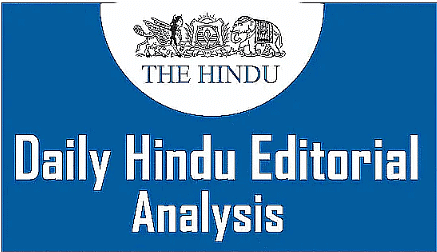The Hindu Editorial Analysis- 27th May 2024 | Current Affairs & Hindu Analysis: Daily, Weekly & Monthly - UPSC PDF Download

Absolute Numbers
Absolute Numbers
Why in News?
A total of 58 Lok Sabha seats in eight States and Union Territories voted on Saturday in the sixth and penultimate phase of the general election 2024. With this, polling has been completed in 28 States and Union Territories, in 486 constituencies. Voting is also over for 105 Assembly constituencies of Odisha.
What are the Key Electoral Reforms Enacted in India?
Foundation and Evolution of the Election Commission of India
Foundation of Election Commission (ECI):
- Established on January 25, 1950.
- Initially led by Chief Election Commissioner Sukumar Sen.
- Originally a single-member body with only the Chief Election Commissioner.
First General Election:
- Held from October 1951 to February 1952.
- Involved 175 million voters.
- Conducted despite challenges like illiteracy and refugee populations.
- Embraced universal suffrage for citizens above 21 years.
Key Legislative Changes and Developments
Lowering of Voting Age:
- The 61st Constitutional Amendment Act of 1984 reduced the voting age from 21 to 18 years for Lok Sabha and assembly elections.
- Aimed to involve the youth in the political process.
Deputation of Staff to ECI:
- A 1985 provision deemed officers and staff involved in electoral rolls preparation as deputed to the ECI.
- During this period, these personnel are under ECI’s control and discipline.
ECI as Multi-Member Commission:
- Became a multi-member body for the first time in 1989.
- Positions of additional election commissioners abolished on January 1, 1990.
- Reinstated as a three-member body on October 1, 1993, consisting of one Chief Election Commissioner and two election commissioners, which continues today.
Transition and Technological Advancements
Transition to Ballot Papers:
- Early elections used colored ballot boxes for each candidate.
- Shifted to paper ballots to streamline the voting process, though manual counting remained a challenge.
Introduction of Electronic Voting Machines (EVMs):
- Provision for EVMs made in 1989.
- First used experimentally in 1998 in selected constituencies of Rajasthan, Madhya Pradesh, and Delhi.
- Used statewide in Goa Assembly elections in 1999.
- Developed by Bharat Electronics Ltd. and Electronics Corporation of India Ltd. under ECI's guidance.
Measures to Ensure Fair Elections
Provision Against Booth Capturing (1989):
- Allowed for adjournment or countermanding of elections in cases of booth capturing.
- Booth capturing includes seizing polling stations, making polling authorities surrender, allowing only certain supporters to vote, and preventing voters from reaching polling stations.
Model Code of Conduct (MCC):
- Enforced rigorously during T.N. Seshan’s tenure as CEC.
- Originated in Kerala in 1960; expanded by 1979 with input from political parties.
- Sought to prevent misuse of power by ruling parties and included measures for fair conduct during elections.
Electors’ Photo Identity Cards (EPICs):
- Introduced in 1993 to improve voter identification and reduce electoral fraud.
Media and Transparency Initiatives
Allocation of Time on Electronic Media (2003):
- ECI allocates equitable time on cable television and other electronic media for election-related content and public addresses.
Restrictions on Exit Polls (2009):
- Prohibition on conducting and publishing exit poll results during elections to Lok Sabha and State Legislative Assemblies.
Online Enrolment in the Electoral Roll (2013):
- Allowed online filing of applications for electoral roll enrolment.
- Governed by the Registration of Electors (Amendment) Rules, 2013.
Enhancements in Voting System
None of the Above (NOTA) Option:
- Introduced in 2013 as per Supreme Court directive.
- Allows voters to abstain from voting for any candidate while maintaining ballot secrecy.
Voter-Verifiable Paper Audit Trail (VVPAT) System:
- Explored by ECI to enhance transparency and verifiability.
- Prototype demonstrated in 2011.
- Enabled by amended Conduct of Elections Rules, 1961 in August 2013.
- First used in a bye-election in Nagaland.
Appointment Procedures
- Appointment of Election Commissioners:
- Initially appointed by the President on the central government’s recommendation.
- March 2023 Supreme Court decision recommended a committee comprising the Prime Minister, Chief Justice of India, and Leader of the Opposition for appointments.
- The CEC and Other ECs (Appointment, Conditions of Service and Term of Office) 2023 law established a selection committee including the Prime Minister, a Union Cabinet Minister, and the Leader of the Opposition or largest opposition party leader in Lok Sabha.
What are the Key Committees Related to Electoral Reforms?
- Dinesh Goswami Committee on Electoral Reforms (1990)
- Vohra Committee on Crime-Politics Nexus (1993)
- Indrajit Gupta Committee on State Funding of Elections (1998)
- Second Administrative Reforms Commission Report on Ethics in Governance (2007) headed by Veerappa Moily
- Tankha Committee (Core Committee) on Election Laws and Reforms (2010)
Indelible Ink- Symbol of Indian Elections
- The indelible ink, a symbol of Indian elections, is used to prevent multiple voting. It contains silver nitrate and remains visible even after exposure to soap or liquids for up to 72 hours.
- The ink, initially made by the Council of Scientific & Industrial Research (CSIR) and patented by the National Research Development Corporation, is now solely produced by Mysore Paints & Varnish Ltd., a prominent undertaking of Govt. of Karnataka and exported to over 25 countries.
Note
- EVMs and VVPATs are designed and manufactured indigenously by Bharat Electronic Limited (BEL), a PSU under the Defence Ministry, and the Electronic Corporation of India Limited (ECIL), another PSU under the Department of Atomic Energy.
UPSC Civil Services Examination Previous Year Questions (PYQ)
Prelims:
Q.1 Consider the following statements: (2017)
- The Election Commission of India is a five-member body.
- The Union Ministry of Home Affairs decides the election schedule for the conduct of both general elections and bye-elections.
- Election Commission resolves the disputes relating to splits/mergers of recognised political parties.
Which of the statements given above is/are correct?
(a) 1 and 2 only
(b) 2 only
(c) 2 and 3 only
(d) 3 only
Ans: (d)
|
38 videos|5288 docs|1117 tests
|





















